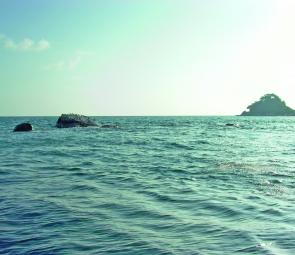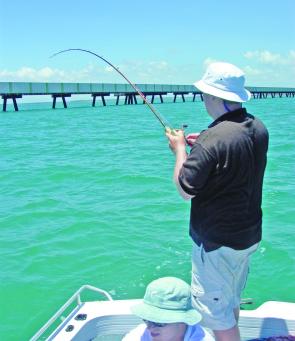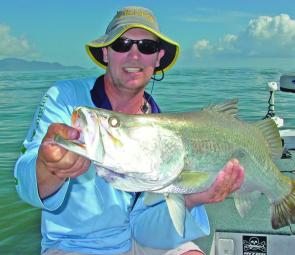Hinchinbrook. With its myriad freshwater creeks, tidal, mangrove lined rivers, rocky headlands and abundant offshore reef complexes, who wouldn’t love the place?
There are not too many anglers who haven’t been to Hinchinbrook or who don’t dream of going there. For many years, this area has been especially captivating for anglers. Hinchinbrook is rich in natural wonders and the fishing can be exceptional. From the pure freshwater reaches of the rivers where jungle perch and sooty grunter are found, to the maze of mangrove creeks where barra, jacks and trevally are lurking, all the way out to the reef where coral trout, giant trevally, nannygai and mackerel live, Hinchinbrook is an angler’s paradise.
Just about everyone who has visited Hinchinbrook and fishes comes away with a special memory or two and it is this fact alone that makes Hinchinbrook such a must visit location. It is a memory maker for anglers.
But it’s not just the fishing that attracts people to Hinchinbrook. The natural beauty of the area, the walking tracks, the sightseeing and the chance to meet dugong and crocodiles up close are just some of the attractions for those not single-mindedly blinded by the fishing.
The Hinchinbrook area was originally occupied by the Bandyin Aboriginal people who lived on Hinchinbrook Island and Europeans didn’t start exploring the area until 1845. The first settler in the Herbert River valley is considered to be Henry Stone, who started a pastoral station in 1865. However by the early 1870s, sugar caners had discovered the rich soils and this is when the area truly took off. Sugar cane quickly dominated the economics of the area and to this day remains a very important part of the Hinchinbrook economy. Tourism and support industries to the sugar industry sprang up and today the Hinchinbrook Shire is a diverse community of many industries.
These days Hinchinbrook Shire has a population of around 13,000 and is spread over 2,600 square kilometres. The major industries are sugar cane cultivation and milling, fishing, tourism, cattle raising, small cropping, prawning, crabbing, production of watermelons and pumpkins and the production of rare and exotic fruits.
The commercial centre for the area is Ingham, located 110km north of Townsville and 245km south of Cairns. However there are many other small towns that are important to the area and these include Cardwell, Lucinda, Halifax, Dungeness, Allingham (Forrest Beach), Taylors Beach, Abergowrie, Toobanna, Macknade, Bemerside, Long Pocket, Stone River, Hawkins Creek, Braemeadows and Forest Home.
Hinchinbrook Island cannot be missed by people visiting the area. The rugged, mist-covered mountains, sweeping beaches, mangrove-lined creeks and rivers and the lush rainforest make Hinchinbrook Island a wilderness of importance.
The area is one of the richest mangrove areas in Australia and many fish species use the mangrove creeks and flats to breed and as an area for the young to grow.
The island is surrounded by marine park waters where fish are plentiful and dugongs and sea turtles are commonly encountered. Fishing is allowed throughout the area, but it pays to check all relevant locations to ensure you are doing the right thing in the right location as fishing restrictions are getting tighter every year. Fortunately, the many kilometres of mangrove creeks and rocky headlands provide abundant opportunities for anglers keen to tangle with a mangrove jack or the famed barramundi.
You can camp on Hinchinbrook Island and fresh water is available along some of the walking tracks, although it is best to check out availability as there are limited camp sites and visitor numbers are restricted.
The walking tracks themselves range from easy hour long trips through to tough and demanding walks that will require a good level of fitness.
A short list of tracks to check out would include:
The Haven track that is about a 1km circuit and will take 15–30 minutes,
Macushla track, Cape Richards that is 5–8km and will take 1.5–2.5 hours,
Thorsborne Trail that can be broken up into smaller section that includes the Ramsay Bay to Nina Bay 4km walk that will take 2.5 hours, Nina Bay to Little Ramsay Bay walk that is 2.5km long and will take 2 hours, Little Ramsay Bay to Zoe Bay walk of 10.5km that will take 6 hours, the Zoe Bay to Diamantina Creek walk that is 6.5km and will take approximately 4 hours, the Diamantina Creek to Mulligan Falls camp of 1km, and the 30 Mulligan Falls camp to George Point walk that is 7.5km long and will take 2.5 hours. The entire walk will take about three days for experienced walkers who are self-sufficient.
On these walks you are encouraged to take plenty of water, sunscreen, insect repellent and food, and you will also need a permit.
For the most up-to-date information check out the Hinchinbrook Island National Park link on the EPA website at www.epa.qld.gov.au.
Now this is the most important part of all when you are considering going to Hinchinbrook. What can I catch, where and when are all pretty important pieces of information to make the best decision. But you also need to consider the likelihood of cyclones, stingers, oppressive heat and humidity and the activity levels of the fish.
Luckily, Hinchinbrook offers the angler something at any time of the year. From hitting the reef areas for mackerel, tuna, marlin and GT in the warmer months, through to chasing tasty bottom fish such as red emperor, coral trout and nannygai in the cooler months, the offshore scene at Hinchinbrook is alive with options.
Within one hour from any of the boat ramps, Hinchinbrook can give up over 100 different species of fish to anglers. There literally are too many to list, but the diversity of the place is amazing. A glassed out day can have you miles out to sea, whereas a day with a bit of wind may see you up the creek casting lures and baits at snags.
If you are more into estuary fishing, Hinchinbrook is best when the barra and jacks are active. This means booking some holidays between February and May or October and December. Remember that there is a closed season for barra between November and February on the east coast, so if you do catch a barra unintentionally during that time it must be released as quickly as possible.
If the freshwater scene is more to your liking, there is no real best time as the fishing for jungle perch and sooty grunter can be great at any time. However, when the water warms a little at the end of the year is often the best time. Light tackle and small lures are the best choice in the freshwater reaches as the greedy sooty grunter and jungle perch just love to prey on small food items. Cast up stream near structure and wind your lures back with an erratic retrieve for some hard pulling action.
Keep in mind that the entire Hinchinbrook Shire is crocodile territory and you need to take all appropriate precautions. Estuarine crocodiles do roam into the fresh water so make sure you are aware of this when chasing the freshwater species. A good local tip is that if you catch a barra or a jack, there is a chance that estuarine crocodiles can reach the spot you’re at!
The freshwater reaches of the creeks and rivers though are worth a visit any time because they are simply breathtaking. This appeal is just enhanced with the knowledge that there are some serious fish in amongst the snags, rocks and weeds so be prepared for some great action.
The prime targets for anglers fishing at Hinchinbrook are barramundi, mangrove jack, nannygai, mackerel and trevally. Below is a list of the best times to target these fish. If you’re new to the Hinchinbrook area, the best advice as always is to hire one of the many competent guides who operate in the area. They will put you onto the fish and provide a great day out and some fantastic memories.
Everyone wants to catch a barramundi at Hinchinbrook. They attack lures and flies with as much gusto as they snaffle a live bait. They fight well, leap high into the air and if you want to keep one for dinner, they provide a great feed too. Barramundi are the pinnacle sportfish as far as many anglers are concerned and they’ll travel a long way or fish for many hours just to catch one.
Barra are best just either side of the closed season. When the water warms it activates the barra out from their winter doldrums and makes them more aggressive towards baitfish. So the best months to look for barra at Hinchinbrook are September, October, February, March and April. While a lot of barra are found in the snags in the rivers, there are plenty of barra to be found over the sand and mud flats, especially where a lone tree provides some shelter for the fish. Casting baits or lures close to the snags repeatedly is a good way to entice a barra onto your line.
You’ll need a 4-6kg outfit (baitcaster or threadline), a handful of lures that include PrawnStars, gold Bombers, Reidy’s B52s, Lead’s Lures, Ecogear SM125s and Killalures, 20kg and 30kg leader, 15-24kg main line, sinkers to suit the current and a range of hooks between 1/0 and 8/0. If you can source fresh prawns, herring or mullet with a cast net, you’ll be in better shape than having to rely on frozen bait.
Mangrove jack are found in similar areas to the barra and at similar time, with the exception being that they do bite a little better through the cooler months. If jacks are your target extend your holiday window a couple of months either side of the best barra months.
You can use the same tackle for jacks as you do for barra, but downsize the lures a little for the best results. The same baits and locations work well for jacks, but they will let you know sooner rather than later that they are interested in what you have so you can spend less time at each spot if jacks are on the menu.
Like barra, jacks eat very well, but understand that most estuary jacks are juveniles and it’s not until they move offshore that they mature to breed, so consider your take carefully.
Nannygai, both large and small mouth, are absolute prime targets for those heading offshore. These red fish can grow to exceptional size and they taste as good as any fish you’re likely to encounter.
Most serious offshore fishers start to get excited about nannygai as the water cools towards winter. If there is a break in the wind, you’ll see plenty of trailer boats and larger heading offshore to a favourite patch of reef or rubble ground.
The tackle needed can be as simple as a sturdy handline with sinker and hook. But other anglers use 10-15kg overhead outfits or 10kg threadline rigs to make the fishing a little more challenging. Baits of fresh squid (caught on site), pilchard, fish flesh or live baitfish are all popular. While the fishing can be good on frozen baits, the real trick is to use fresh or live baits for the best catches.
Mackerel and trevally can be caught all year round too, but their peak times are in the cooler months.
Keen mackerel fishers love floating out pilchards in a berley trail or slow trolling garfish rigged on a ballyhoo rig with a squid skirt over the top. Others troll garfish rigged with a chin sinker, squid skirt and ganged hooks.
Commonly 10-15kg overhead outfits are used when targeting mackerel as their first run can be awesome. After this initial dash for freedom though they do come relatively easy.
Giant trevally are a powerful and unforgiving fish that will test any tackle. Around Hinchinbrook you can catch them all year from small 1kg creek models through to the true giants that prowl around the offshore reefs and headlands scaring everything within their range.
Most anglers like to popper fish for the big GTs because it’s so spectacular. Even in the creeks you can popper fish for GTs but don’t be surprised if a barra or jack latches onto your popper.
If you’re into serious GTs then you’ll need serious tackle and serious lures. Tackle in the 24-36kg range that can be cast and reels that can handle line up to 36kg are needed. This is specialised fishing with specialised tackle. There are many game fishing operations that target big GT and operate out from Hinchinbrook, so it will be well worth your time and money getting on board with one of these operations and letting them supply the tackle, experience and location.
So the fishing options at Hinchinbrook are year round. Depending on your target species, you can visit Hinchinbrook and expect to be hooked up to your quarry in short order. All of the species available at Hinchinbrook can be caught year round, but there are peak seasons. Give yourself the best chance and plan ahead. Hire a guide and have some of the best fishing you’ll experience in Queensland.
If you’re travelling with the rest of the family and they’re not keen on fishing 24/7, there are plenty of fish-free, family-friendly options in the Hinchinbrook area that are sure to please.
Once you’ve had your fill of lounging on the beach, why not head to one the of the region’s many freshwater swimming holes? Popular locations include Crystal Creek (Paluma), Five Mile Swimming Hole, Wallaman Falls, Jourama Falls, Broadwater, Zoe Bay and Mulligan Bay. All of the swimming holes are located in National Parks or State Forests and most have toilet and barbeque facilities. You can find out more at www.hinchinbrooknq.com.au.
Bird watching is another popular option with raftons, owls, birds of paradise and other species throughout the region all available for the keen watcher. Combine this with some of the walks and you have the makings of a great day in the Hinchinbrook wilderness. For more information contact John Young on (07) 4777 1271.
Tyto Wetland is located near Ingham and features lagoons, lookouts and walking tracks. For sheer beauty it is hard to beat the Tyto Wetlands. The Tyto Wetlands is also home to over 200 bird species, so you can easily combine your love of bird watching with the spectacular backdrop that Tyto provides. For more information visit www.hinchinbrooknq.com.au/trsm_tyto.htm.
There are several areas around Cardwell worth checking out as well, including the Cardwell Lookout and Forest Drive and the Rainforest and Reef Centre. For more information visit www.csc.qld.gov.au.
The Great Australian Corroboree will be held in Cardwell over 9-14 October, and you can find out more at www.greataustraliancorroboree.com.au.
You can base yourself at Ingham, Cardwell, Lucinda or any of the smaller towns and hamlets in the area and be within half an hour’s travel from some of the best tourist activities available on mainland Australia. And of course the Great Barrier Reef Marine Park is right on your doorstep too. This world heritage listed icon of Australian tourism is a must visit when you’re in the area – and that goes for the angler in the family as well.
Hinchinbrook Island inhabits a part of the angler’s imagination like few other places in Queensland. It is a rich and productive ecosystem which means that you, as a keen fisho, will find much to be excited about, while those you drag along with you are bound to find the beauty of this place equally inspiring. There really is something here for everyone. Most anglers head here for the barra, particularly in the warmer months, but don’t only get hung up on this fish. The estuaries and outlying reefs are rich grounds and the offshore fishes well with some brilliant species to be had.
It’s a year-round destination, so when you get a break, make the worthwhile effort to head to one of Australia’s best island parks. It’s just the place to recharge your batteries and see some amazing wildlife and scenery.
Reads: 11760








